It may seem sleepy but a stay in Storms River Village is bound to get the heart thumping. Paul Maughan-Brown and Teagan Cunniffe paddled, swam, jumped and walked their way through five days in adventure central.
Also read: Zip through a World Heritage Site with Cape Canopy Tours
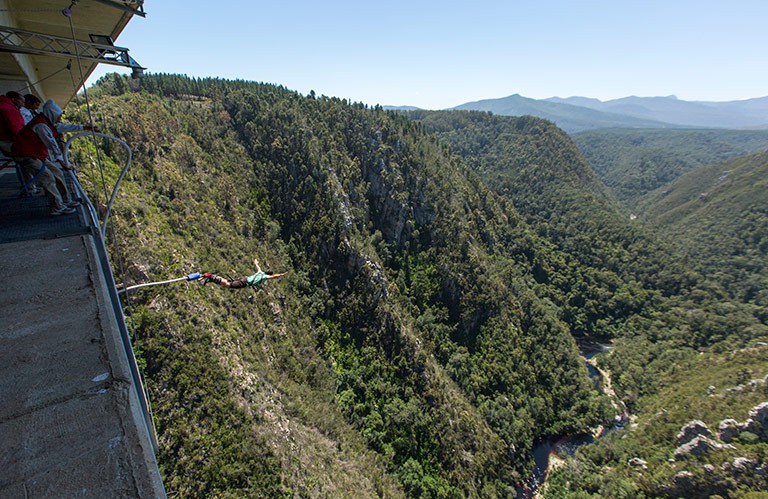
Bungy jump off the Bloukrans Bridge.
One by one we jump. Force our heads down. Watch the world spin. Wait for the splash and feel of our tubes, buoyant beneath bums (queue satisfaction). Front flips nailed, we sit pretty in the Coca-Cola water of Storms River. Here the rules are simple: capsizing anyone is fair game, but only from atop your inflated vessel. An hour- and-a-half later, weary-armed and ready for a cold beer, it’s on to the bakkie, up the long road through lush indigenous forest and back into Storms River Village.
Similar vehicles drive through town regularly during the day, packed with people of all ages, clad in harnesses, helmets, wetsuits and life jackets. Booted-up hikers enter town from the east after exploring the forests, and cyclists remove mud-splattered sunglasses after having conquered the old pass through the river gorge. A 20-minute drive away, the coastal reserve of the Storms River Mouth allows for snorkelling and sea kayaking. It doesn’t take much longer to get to the Bloukrans Bridge and the world’s highest bungy jump where, hearts pounding, palms sweaty, nerves on edge, people leap, hollering, into the abyss.
At first glance, Storms River Village is not easily recognisable for the adventure hub that it is. Fresh-mown grass verges and beds of purple and blue agapanthus complement big old oaks and gums, giving a cool softness to the picturesque town. The back-drop to the north is Storms River Peak, part of the Tsitsikamma Mountains, and an imposing form at just more than 1000 metres high. To the south and east lie stretches of protected indigenous forest surrounding the town in a natural buffer zone. These thrive in a place where rainfall is so reliable it was pegged long ago as a defining characteristic: ‘Tsitsikamma’ translates from Khoi to ‘place of abundant water’ (or place of sparkling water, depending on who you ask). An average of 1200 millimetres a year keep the forests lush and feed rivers, carving out deep gorges from the mountains to kilometres of protected coastline. It’s these natural assets that provide the scaffolding for a tourism industry which keeps the town going.
Indeed it was the allure of forest shenanigans that attracted people with the means to develop the land in the first place. The town’s first building was a shooting box built by a Lieutenant TH Duthie in 1841, used as a base for hunting the abundant wildlife that thrived in the dense vegetation. Today, it’s used only for shooting the breeze as patrons sip beers in Hunter’s Pub, which incorporates aspects of the original building. The pub forms part of the Tsitsikamma Village Inn, next door to which is the newly opened Tsitsikamma Microbrewery. Pouring me a glass of delicious ale, pony-tailed, permanently grinning co-owner of both, Chris Sykes, gives me a little insight into the workings of the village.
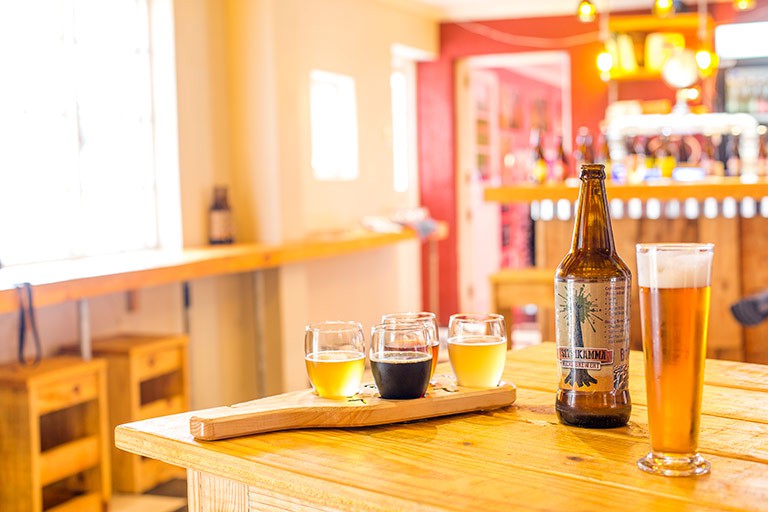
Tsitsikamma Microbrewery.
The whole place is run independently of government support, through the co-operation of its residents; from planting pretty agapanthus to patching potholes. Electricity is bought directly from Eskom, and water comes from boreholes or the heavens. The most significant piece of help the village gets is from the country’s second most important road. The sheer volume of tourist traffic moving through the Garden Route on the N2 means that by 7pm guest houses’ parking lots are packed with rented cars. Couples stroll the streets on their way to restaurants, many probably debating whether to stay for an extra day in this unexpectedly lovely town.
If they do, they’ll likely catch the infectious energy of the people who run things here. Constantly kinetic young guys strap rudimentary life support to ankles on Bloukrans Bridge. Guides who’ve worked on the Tsitsikamma Canopy Tour for more than a decade whoop in amusement at the sight of Knysna dwarf chameleons chasing each other up tree trunks. People seem stoked to be doing their jobs, excited to see what you’ll make of their piece of paradise. And with so many pieces to be enjoyed, what’s not to be stoked about?
Also read: Guide to some of South Africa’s best little towns
Plan your trip to Storms River
From Plettenberg Bay, turn right off the N2, 4.5 kilometres past the turn-off to the Storms River Mouth, 60 kilometres east of Plettenberg Bay. From Port Elizabeth, turn left off the N2, 5.7 kilometres past the Storms River Bridge and Total garage, 172 kilometres west of Port Elizabeth.
Google maps: -33.96359, 23.8579519
Storms River activities
1. Snorkelling
In the Tsitsikamma Section of the Garden Route National Park, a marine protected area, there is high potential for spotting sharks and rays, small fish and even the occasional octopus. Hour-long guided snorkelling trips are available or adventurers can hire gear and go it alone. Costs R300 for a guided trip of an hour or R180 an hour for gear hire (includes wetsuit, fins, mask and snorkel).
2. Segway tours
Take a Segway tour through pine plantations and indigenous forest on a space-age scooter-meets-Zimmer-frame. The two-hour ride takes Segwayers to an 1000-year-old giant Outeniqua yellowwood. A one-hour tour into the forest of the Plaatbos Nature Reserve is also available. Open daily with tours running on the hour. Maximum seven people per tour; minimum height 1.1 metres; maximum weight 120 kilograms. Costs R300 for one hour, R450 for two hours.
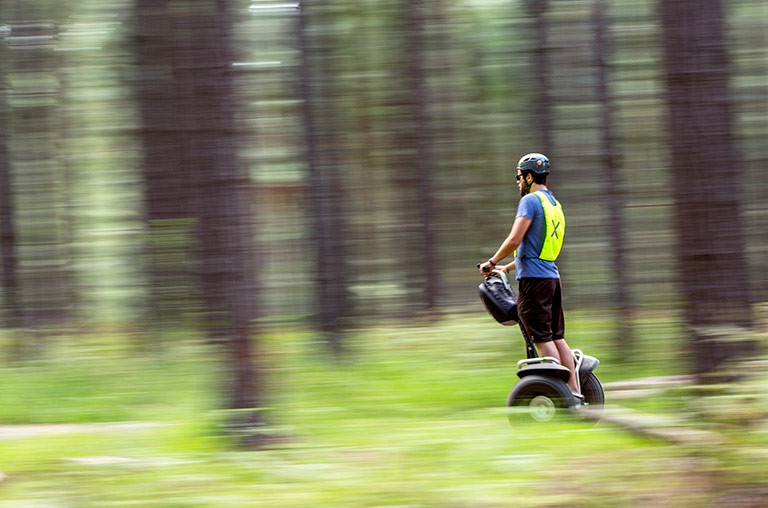
Take a Segway tour through pine plantations and indigenous forest.
3. Kayaking
Kayak and lilo along the shoreline and into the Storms River Mouth. Paddlers take two-man sea kayaks along the coast and into the mouth before transferring to a heavy-duty lilo to traverse rocky river pools and plunge from the cliffs into dark water. Trips last three hours and paddlers must be older than seven years. Closed shoes that can get wet are a necessity, but booties are available for hire at R30. Costs R399 per person, including a wetsuit and a bottle of water.
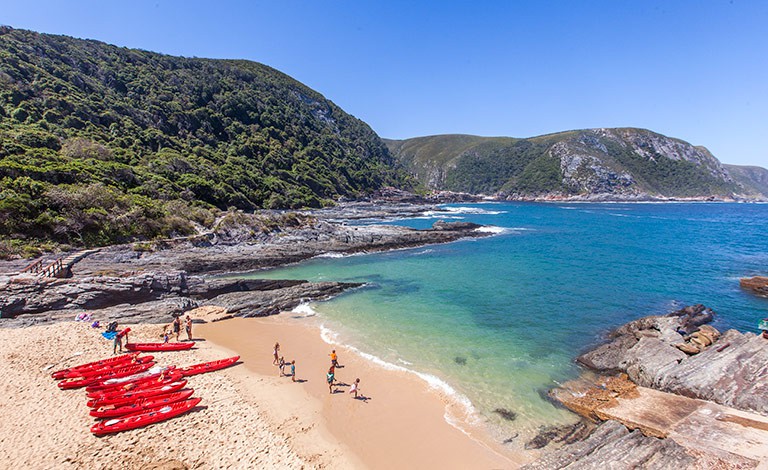
Kayak and lilo along the shoreline and into the Storms River Mouth.
4. Mountain-biking
Mountain-bike the scenic and undulating Storms River Pass on a 22-kilometre trip through the river valley and up to the coastal plateau. If you don’t have your own bike you can rent one from Mild 2 Wild Adventures, open from 8am to late. Costs R150 for an hour or R200 for four hours.
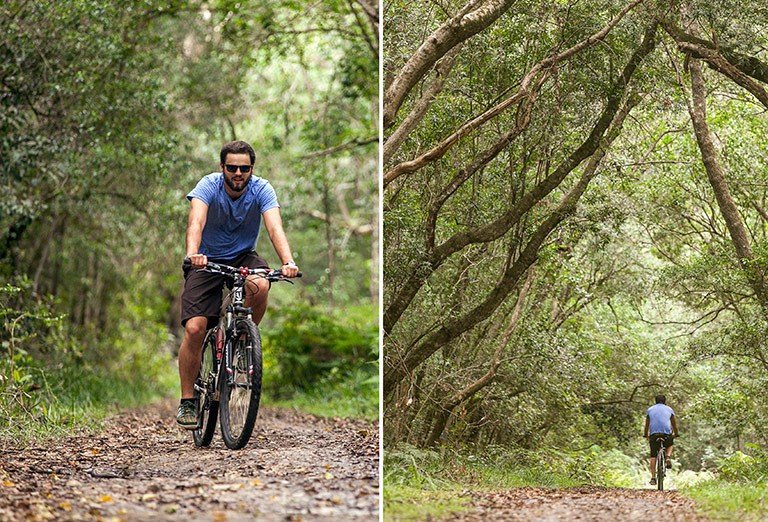
Mountain-bike the scenic and undulating Storms River Pass.
5. Ziplining
Zipline along cables across the Kruis River, just metres above a series of flowing waterfalls. Runs daily, with tours departing regularly. Guests must be three years or older. Costs R375 per person.
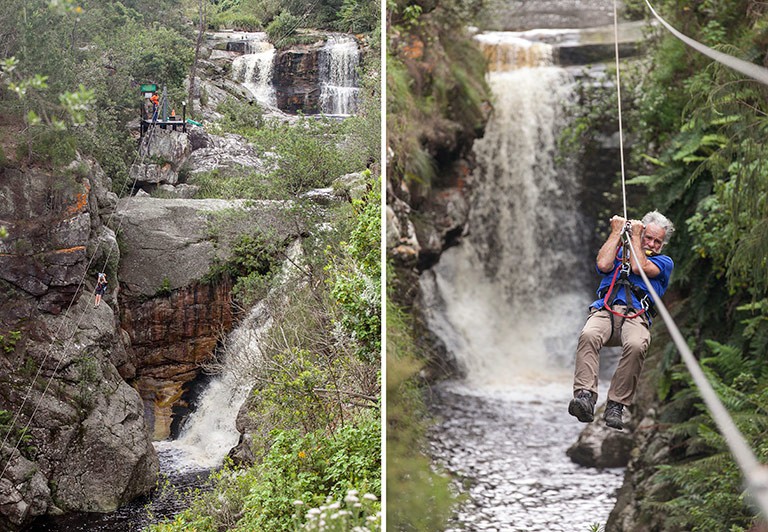
Zipline along cables across the Kruis River.
6. Canopy tours
Take a canopy tour through the forest, whizzing 30 metres above the ground. Runs daily, departing every half-hour between 8am and 6pm. Costs R595 per person, including a light meal and transport.
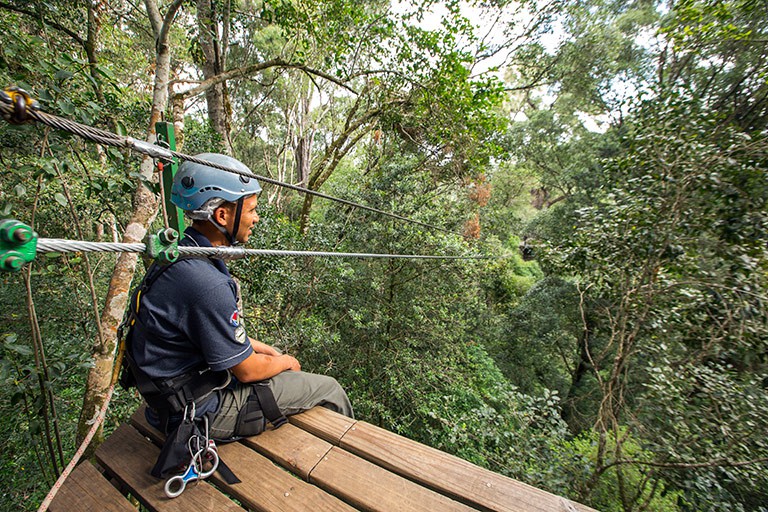
A Tsitsikamma canopy tour zips 30 metres above the ground, among 700-year-old Outeniqua yellowwoods and Knysna loeries. Age limits are officially seven to 70, but this is negotiable, depending on harness fit and general physical ability.
7. Tubing and cliff jumping
Tube on mini rapids and tackle cliff jumps along the (usually) tranquil Storms River. Half-day trips start at 8.30am and 12.30pm, while the full day starts at 9am and lasts six hours. Tubers must be 12 years or older. Full-day tour requires moderate fitness. Costs R490 for a half-day, R810 for a full day, with national park fees included in both, and a light lunch included in the latter.
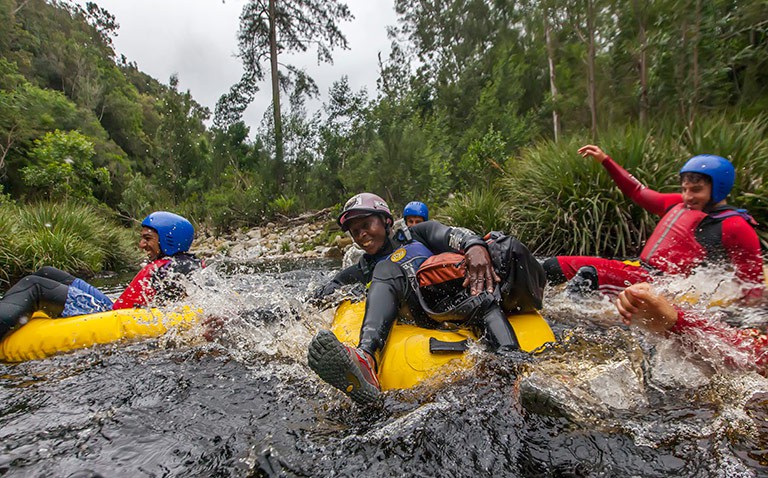
Tube on mini rapids and tackle cliff jumps along the (usually) tranquil Storms River.
8. Bungy jumping
Bungy jump off the Bloukrans Bridge, the world’s highest commercial bridge bungy, at 216 metres. Jumpers must be 14 years or older. Minimum weight is 35 kilograms, maximum weight is 150 kilograms. Open seven days a week. Costs R850 per person.
9. Hiking and walking
Hike the three-hour (return), three-kilometre coastal trail to a waterfall that cascades into a dark pool of fresh water before trickling into the sea. There are also three trails through the indigenous forest in Plaatbos Nature Reserve, ranging from five to eight kilometres. Entrance to Plaatbos is free, but hikers are required to take a self-issue permit from a box at the gate. The waterfall trail requires paying the conservation fee for Storms River Mouth, which is R42 for adults, R21 for kids.
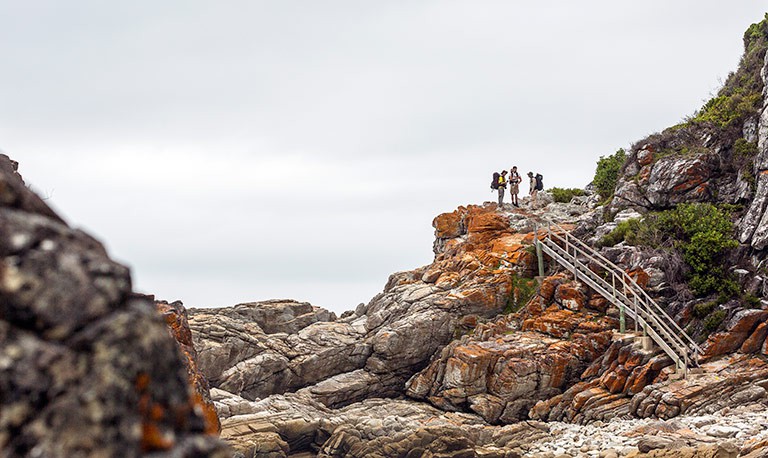
Hike the three-hour, three-kilometre coastal trail.
Places to eat in Storms River
- Papa Africa is a rustic pizza place in Darnell Street where you can kick back to some mellow reggae. Note, ‘pizza place’ isn’t meant as shorthand for Italian restaurant – there’s nothing else on the menu. Costs R70 for a large pizza with four toppings, prepared and cooked in a wood-fire oven in front of you. Cash only.
Tel 0422811050.
- Cattle Baron probably has one of the best locations in town. Tables on the deck overlook the rocky coastline and the river mouth in the distance. With steaks and burgers starting at R55, it’s hard to imagine finding something more satisfying after a hike or paddle.
Tel 0422811190.
- Marilyn’s 60’s Diner is retro deluxe, with a pink jukebox playing rock ’n roll next to a 1961 Dodge Lancer and a 1954 BMW R26 motorbike, among numerous other vehicles. The restaurant is dedicated to Elvis and Marilyn Monroe, and is loud, proud and pink. A diverse menu offers everything from vintage American cocktails to brie and chutney wors rolls.
Tel 0422811711.
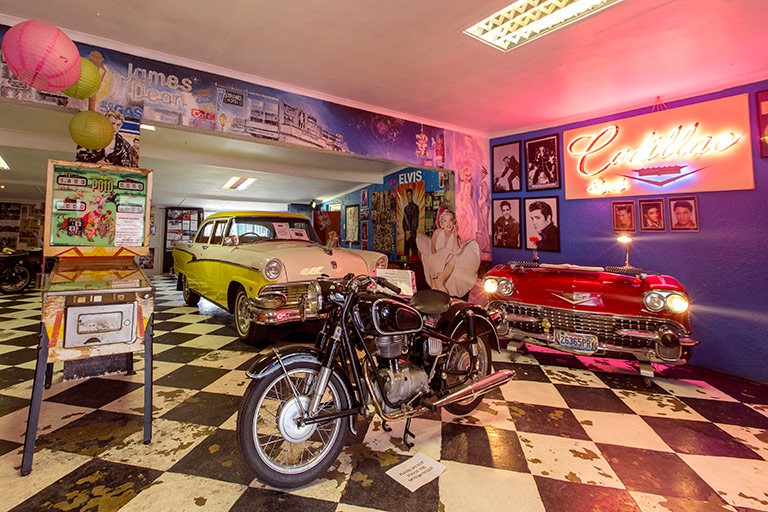
Marilyn’s 60’s Diner.
Places to stay in Storms River
1. Tube ’n Axe Backpackers
Tube ’n Axe Backpackers is a laid-back spot, with a pool, foosball tables, a large outside fire pit, camping grounds and a bar that’s open late. Accommodation varies, from dorm rooms and platformed tents to shared private rooms and A-frame log cabins. A limited à la carte dinner is available, as well as a breakfast buffet. Costs from R80 per person camping and R195 per person sharing for private shared rooms.
2. Tsitsikamma Village Inn
Tsitsikamma Village Inn comprises 49 individually decorated rooms, built in a variety of colonial styles and all facing inward across a manicured square. The slick operation has earned it the title of ‘the hotel’ among locals. Start the day with a delicious buffet breakfast in the restaurant, and end it with a pint in the Hunter’s Pub – built where the original Duthie shooting box was, and decorated with animal trophies and old rifles. B&B costs from R350 per person per night sharing.
3. At the Woods Guest House
At the Woods Guest House has eight comfortable rooms with TVs, tea and coffee facilities, bar fridges and en-suite bathrooms with spacious showers. There’s also a pool and views of the mountains from the deck. Marco Coetzee, who co-owns the place with his wife Bev, did much of the wood- work in the lodge. B&B from R475 per person per night sharing.
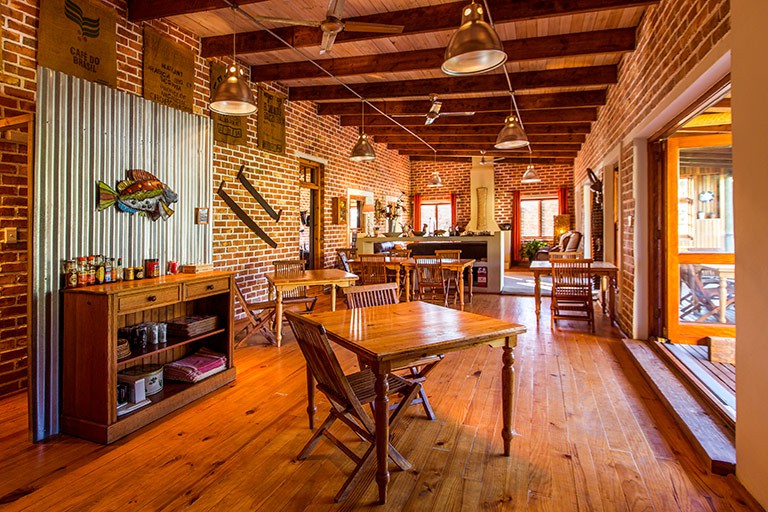
At the Woods Guest House has eight comfortable rooms.
4. The Green House
The Green House is a well-equipped self-catering house on a large property with ample lawn space for kids to run riot. The two en-suite rooms, one with a fireplace, have beautiful views of the Tsitsikamma Mountains. A lounge complete with full DStv opens on to a deep stoep with a braai for perfect summer evenings. Costs from R750 per night for the house.
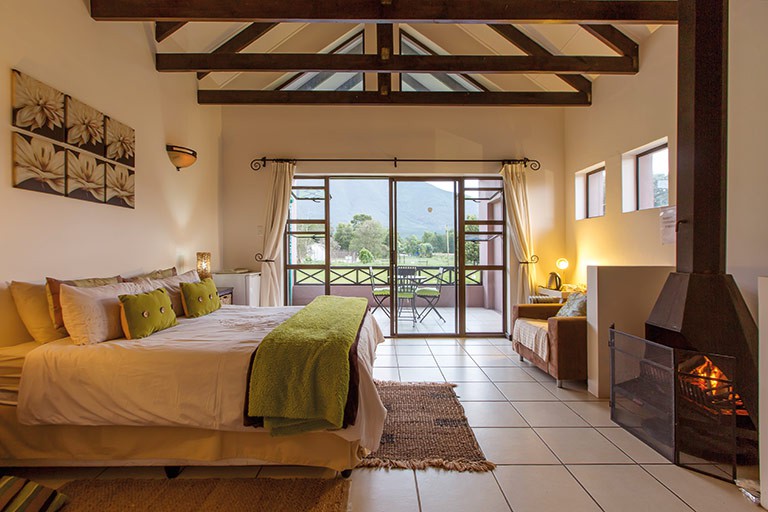
The Green House is a well-equipped self-catering house.
This article first appeared in the February 2015 issue of Getaway magazine.
Get this issue →
All prices were correct at time of publication, but are subject to change at each establishment’s discretion. Please check with them before travelling.
You may also like
Related Posts
Whether you’re in a two-person hiking tent eye-balling the peaks or a full caravan in...
read more
A new guided hike in the Western Cape known as the 16 Mile Beach Challenge...
read more
Adventure seekers often look to push try new experiences which take them to the edge...
read more